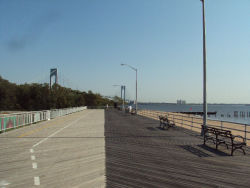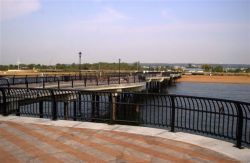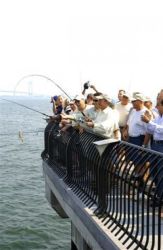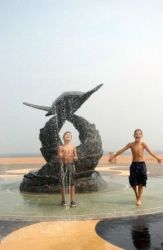Franklin D. Roosevelt Boardwalk and Beach
Bobby Thomson Field
This field, located along the northernmost segment of Staten Island’s FDR Boardwalk and Beach between Fort Wadsworth and Sea View Avenue, honors baseball star Bobby Thomson (b.1923).
Bobby Thomson, a famous sportsman and Staten Island resident, became the star of the 1951 Major League Baseball pennant race, which pitted the Brooklyn Dodgers against the New York Giants. The ever-present rivalry between the two New York teams had grown fiercer at the Polo Grounds on October 3rd when Giants third baseman Bobby Thomson stepped up to the plate in the bottom of the 9th inning. The Dodgers had been leading 4-2; but, with two men on base, Thomson struck Ralph Branca’s (b.1926) high inside fastball into the left field stands to win the Pennant for the underdog Giants. Thomson’s home run was later called “the shot heard round the world.”
Colonized in 1661 by a small Dutch community, the coastal neighborhoods of Middle and South Beach changed little until the l880s. Around that time, local investors recognized the potential of teeming beaches filled with New Yorkers trying to escape the city’s summer heat. With the addition of hotels, bathing pavilions, theaters, beer gardens, shooting galleries, carousels and Ferris wheels, the beachfront area became a resort almost overnight. Soon the casinos and the Happyland Amusement Park took advantage of the summer seasonal closing of most Broadway theaters by staging their own theatrical productions and vaudeville shows. By 1890, ferries, trains and trolleys filled to capacity with vacationers and day-trippers trying to reach Staten Island’s beaches. By the 1920s, the number of Staten Island visitors could run upwards of 40,000 per day. Eventually several destructive fires, increasing local water pollution, and the Great Depression (1929-1939) took their toll on the beachfront resort area and the crowds began to disappear rapidly.
In 1935, the City acquired this beachfront property and soon began renovations as part of President Franklin Delano Roosevelt’s (1882-1945) Works Progress Administration (W.P.A.). While providing jobs for Depression-era workers, the project also revived the community of South Beach. Workers removed the deteriorating music halls, carousels, and shooting galleries and laid down the present two-and-a-half mile long boardwalk. In 1939, the boardwalk was dedicated to the former New York governor and president and has since continued to undergo periodic renovations and neighborhood improvements. Children can now enjoy playgrounds, baseball fields, and handball and shuffleboard courts maintained by Parks. Visitors can also enjoy bocce courts, checker-tables, a skateboard park, a roller hockey rink and a long pier for year-round fishing.
After several years, many public meetings, and $6 million drawn from the 1973-74 Federal Budget, nearby Miller Field became part of the Gateway National Recreation Area. In the early 1990s, this site was chosen for the construction of two new baseball fields and a soccer field for the South Beach community and their summer visitors. In 1995, Parks installed a new roller hockey rink nearby funded by $15,000 City Parks Foundation grant. In 1996, Saturn of Staten Island funded the construction of a new a $30,000 South Beach playground. That same year, the baseball fields of South Beach underwent a $1,692,657 renovation project. Though South Beach has changed over the years, it remains an active residential community and a beautiful scenic resort for visitors.
Check out your park's Vital Signs
Clean & Safe
Green & Resilient
Empowered & Engaged Users
Share your feedback or learn more about how this park is part of a
Vital Park System










